India on Sunday, January 26, 2020, celebrated the 71st Republic Day with a military parade showcasing the latest military equipment, armored vehicles and main battle tanks which are now in services with the Indian armed forces. Analysis and technical review by Army Recognition editorial team of tanks, combat armored vehicles and field equipment showcased by the Indian army during the military parade for the Republic Day 2020.
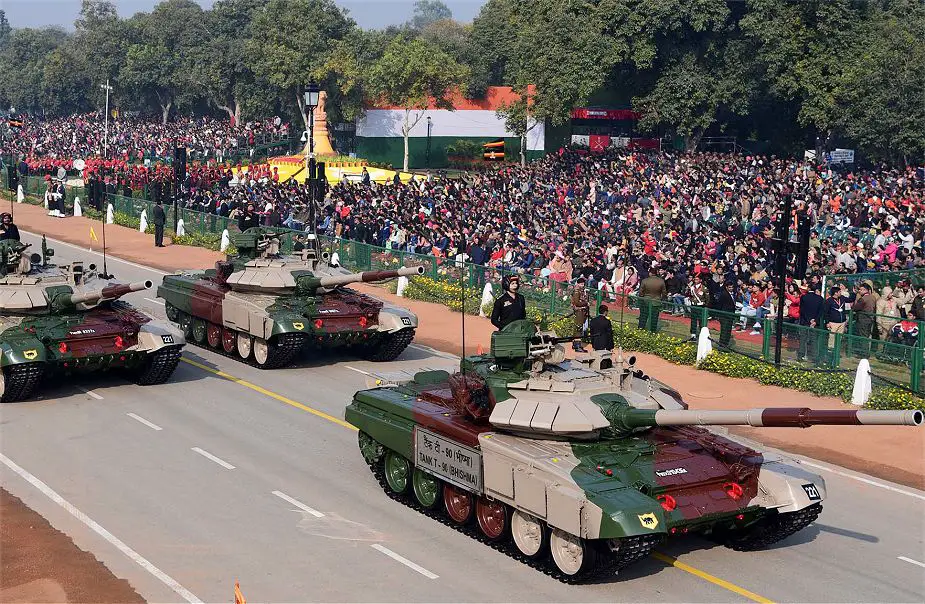
T-90S Bhishma main battle tanks at India Republic Day military parade, January 26, 2020. (Picture source Indian MoD press service)
At the Indian Republic Day military Parade 2020, India has showcase lot of military equipment and combat vehicles including the local-made developed artillery gun system 'Dhanush', the main battle tank of the Indian Army T- 90 Bhishma, the new self-propelled howitzer K-9 VAJRA-T and Advanced Light Helicopters- Weapon System Integrated Rudra and 2 Advanced Light Helicopters, Dhruv of Army Aviation.
T-90S Bhishma
The T-90S Bhishma is an improved version of the Russian-made T-90S main battle tank. this tank is manufactured under license in India since 2004.
The main armament of the T-90S MBT includes one 125 mm 2A46M smoothbore gun. A coaxial machine 7.62 mm PKT is mounted to the right side of the main armament and a 12.7mm air defense machine gun is fitted to the top of the turret.
The T-90S is also able to fire the 9M119 Refleks (NATO designation AT-11 Sniper) anti-tank guided missile system with a range from 100 m to 4,400 m. It can be used to destroy tank fitted with explosive reactive armour (ERA), as well as low-flying air targets such as helicopters, at a range of up to 5 km.
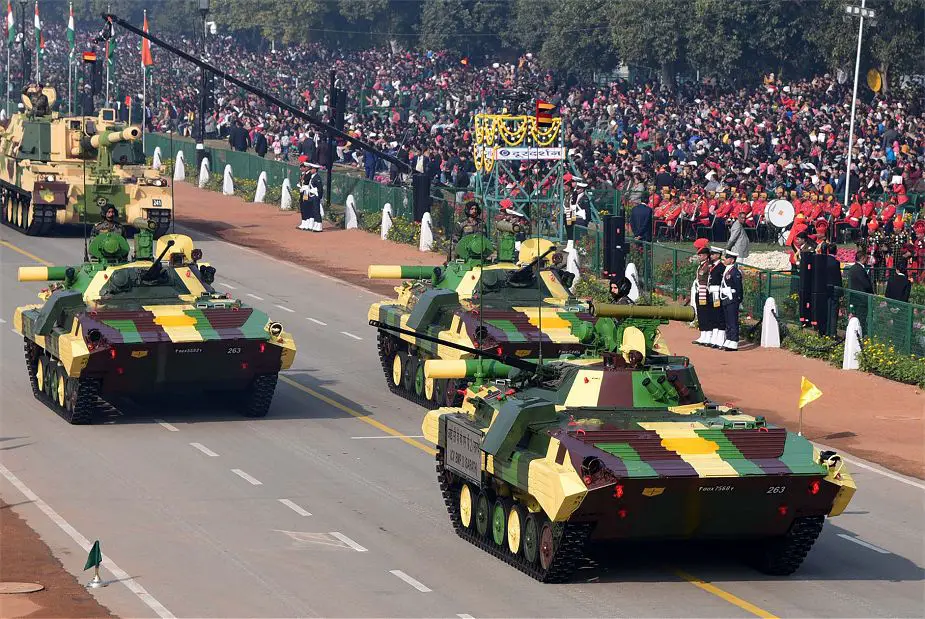
BMP-2 Sarath tracked armored IFV Infantry Fighting Vehicle (Picture source Indian MoD press service)
BMP-2 Sarath
The BMP-2 Sarath is an Indian version of the Russian-made BMP-2 tracked armored IFV (Infantry Fighting Vehicle). In 1984, India has ordered 700 BMP-2 from Russia that were delivered between 1987 and 1991 (most produced in India). A total of 400 BMP-2 Sarath ordered in 1985 were produced under license in India.
The BMP-2 Sarath is fitted with a two-man turret armed with a stabilized 30 mm cannon 2A42 and a 7.62 mm PKT coaxial machine gun mounted to the left of the main armament with 2,000 rounds. Mounted on the turret roof between the gunner's and commander's hatches is a launcher for an AT-4 SPIGOT or AT-5 SPANDREL ATGM (Anti-Tank Guided Missile) which has a maximum range of 4,000 m.
The BMP-2 Sarath is similar to the Soviet-made BMP-2 but there is special protection mounted around the exhaust.
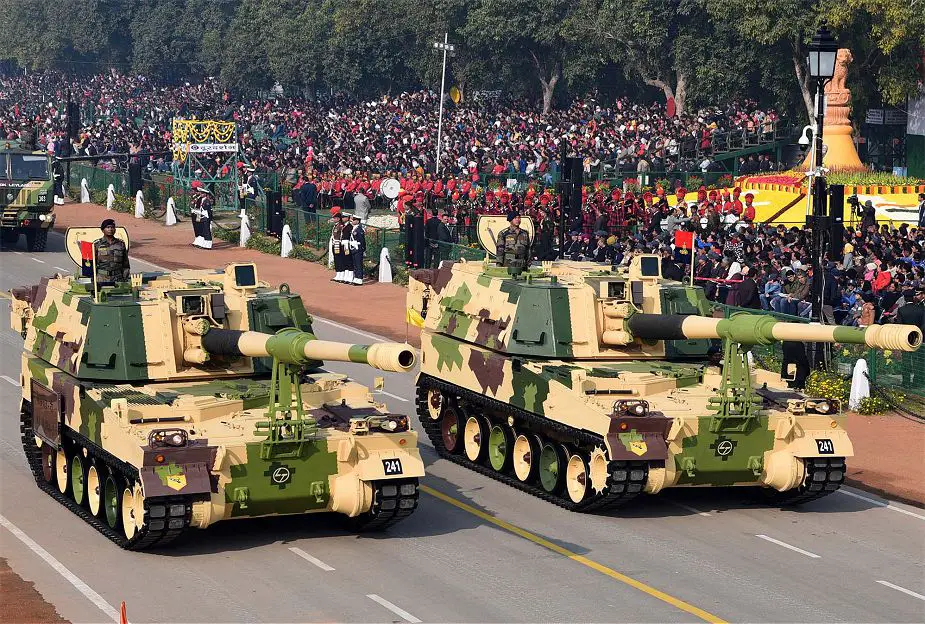
K9 Vajra-T 155mm 52 caliber self-propelled howitzer (Picture source Indian MoD press service)
K9 Vajra-T
In May 2017, the South Korean defense company Samsung-Techwin, along with its local Indian private-sector partner Larsen & Toubro (L&T), signed a contract for the sale of 100 modified K-9 Vajra 155mm self-propelled howitzers based on the South Korean K9 Thunder.
The main armament of the K9 Thunder consists of a 155 mm/52 caliber ordnance with a maximum firing range of 40 km. A total of 48 projectiles and their associated charges are carried for ready use. Internally an automatic loading system takes projectiles from the storage position and places them onto the ammunition tray ready for ramming.
The Indian variant of the K9. Manufactured by Larsen & Toubro under license, consisting 50% component (by value) including 14 major sub-systems developed by Indian companies. It has been customized as per desert conditions.
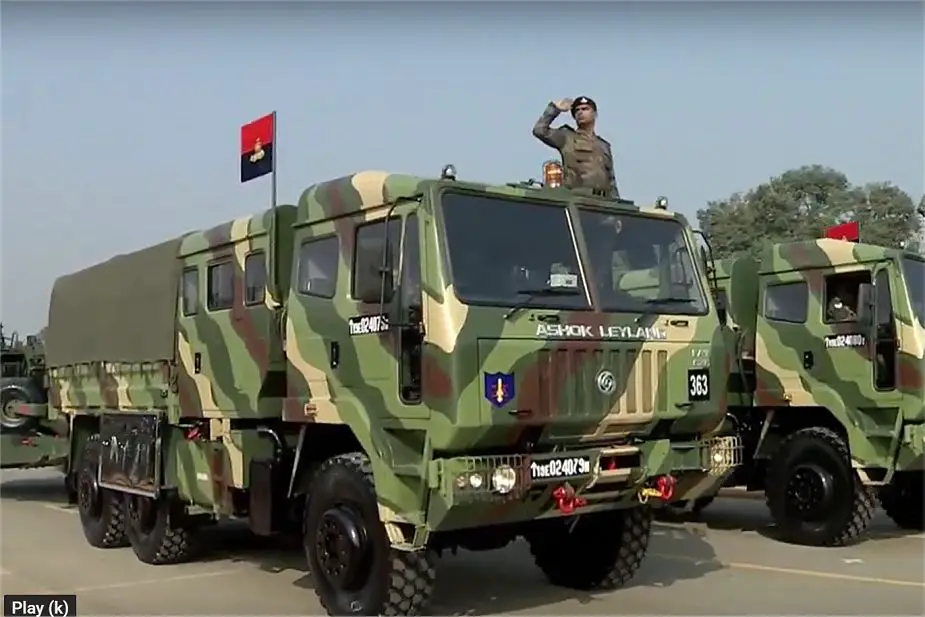
Ashok Leyland FAT 6x6 military truck. (Picture source Indian MoD press service)
Ashok Leyland FAT 6x6
The Danush howitzer is towed by an Ashok Leyland FAT 6x6 truck chassis. The Ashok Leyland FAT 6×6 is an all-terrain military truck developed and produced by Indian automobile manufacturer Ashok Leyland. Designed for towing heavy artillery guns, it will replace the aging fleet of Scania SBAT111S used by the Indian Army.
The truck is designed on Leyland's "Super Stallion" platform. It is powered by Ashok Leyland's in-house developed 8-liter Neptune series engine that gives 360 hp (270 kW) of power and 1,400 Nm of torque at 1,300 rpm. The engine is coupled to an 8-speed manual transmission (2-speed transfer case). The truck runs on a full-time 6-wheel drive system with all axles having a differential lock.
The FAT 6x6 can run at a maximum road speed of 86 km/h with a maximum operational range of 700 km.
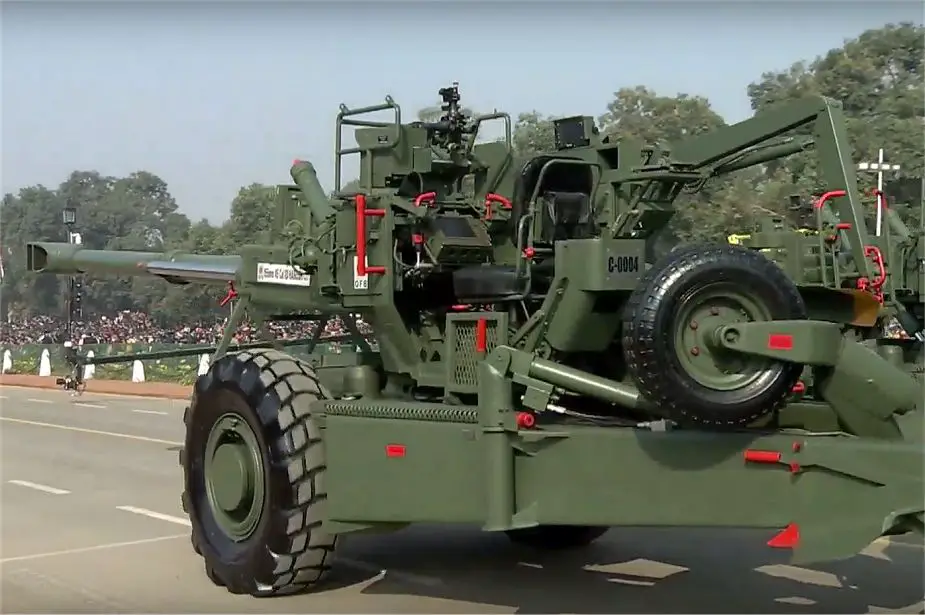
Dhanush 155mm/45 caliber towed howitzer. (Picture source Indian MoD press service)
Dhanush 155mm/45 caliber towed howitzer
The 'Dhanush' gun system, commanded by Capt. Mrigank Bharadwaj, was part of the Republic Day celebrations at Rajpath for the first time on Sunday, January 26, 2020. The 155mm/45 Caliber Dhanush gun system is a towed Howitzer designed indigenously by the Ordnance Factory Board.
The gun has a maximum firing range of 36.5 km and has the capability of automatic gun alignment and positioning. The gun, which is equipped with an inertial navigation system and advanced gun sighting system, has been designed to meet the futuristic requirements of the Army.
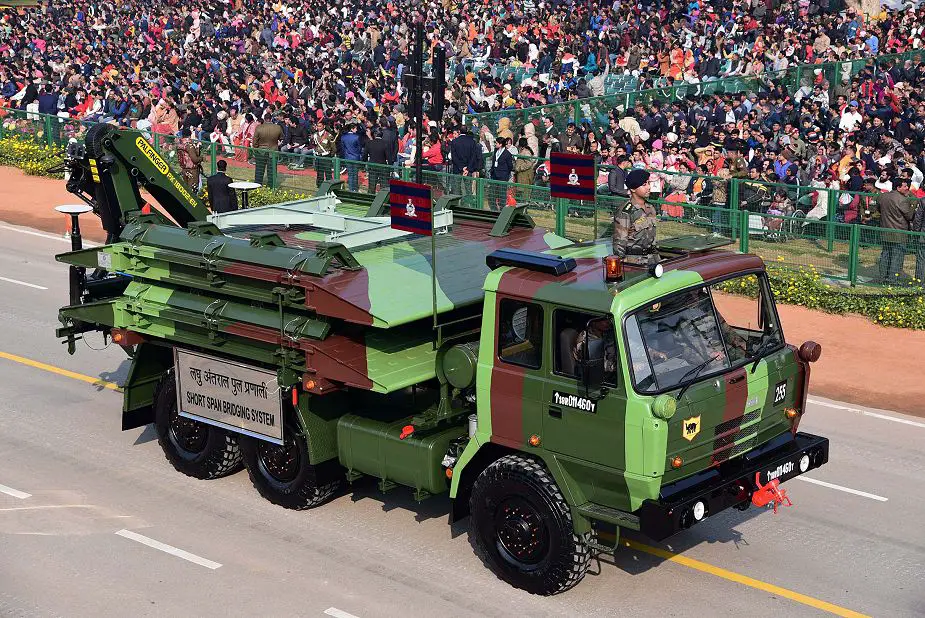
Short Span Bridging System. (Picture source Indian MoD press service)
Short Span Bridging System
The Short Span Bridging System 5m is a mechanically launched bridging system of MLC-70 load class to bridge small gaps and canals. In addition to bridging the smaller gaps, this bridging system will be compatible with SARVATRA bridging system.
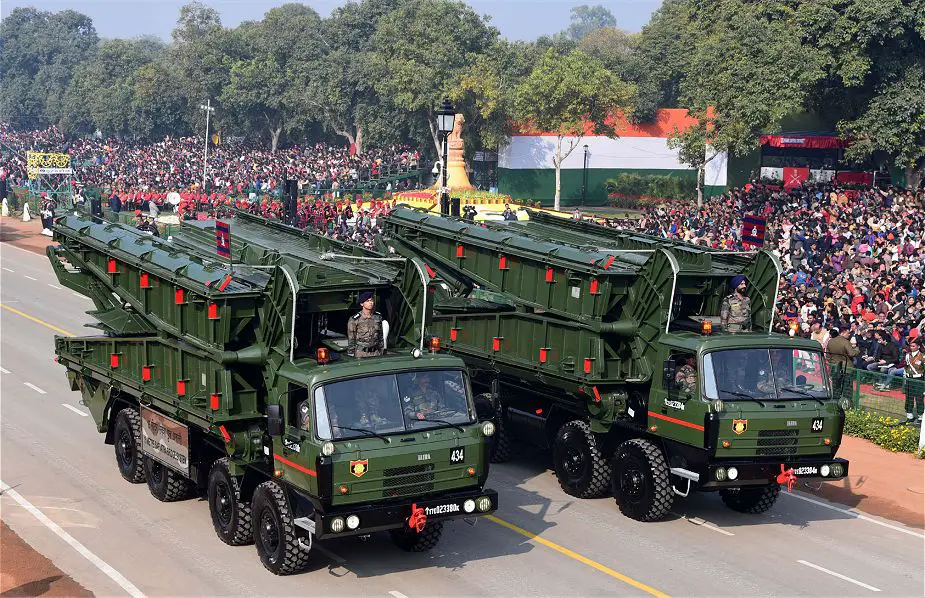
Sarvatra 1 5m mobile bridging system on BEML Tatra truck. (Picture source Indian MoD press service)
Sarvatra 15m bridging system
The Sarvatra truck-mounted bridging system designed by R&DE (Engineers) of Defence Research and Development Organisation (DRDO) for the Indian Army and manufactured by BEML. The Sarvatra bridging system is mounted on BEML Tatra T-815 8×8 truck chassis.
The Savatra is a mobile bridging system using a modified Tatra 815 VVN 8 x 8 truck chassis. The Sarvatra is a 75 meters long multi-span mobile bridging system consists of five scissors bridge made of an aluminum alloy having a span of 15 meters each mounted on separate mobile platforms.
When the 15 meter long scissors bridge is opened out it is fitted with adjustable trestles to enable a number of units to be used to bridge wet and dry gaps. All five sections are laid to provide a total bridge length of 75 m providing a roadway of four meters. The bridge is launched/recovered from either end. With the help of telescopic legs, the height of the bridge is adjusted from 2.5 m to 6 m so that it is not easily visible from far.
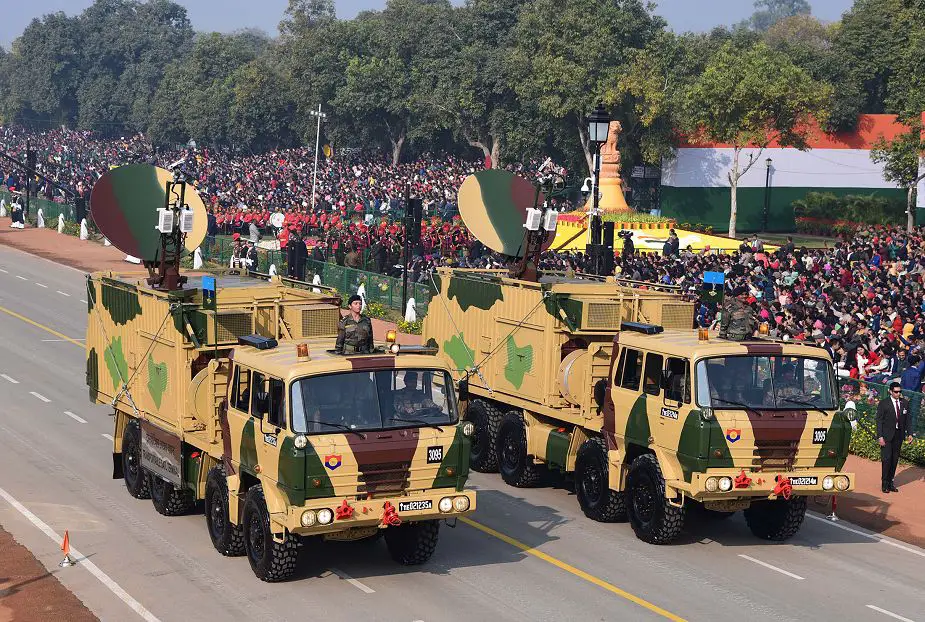
Transportable Satellite Terminal (TST Vehicle. (Picture source India MoD press service)
Transportable Satellite Terminal (TST Vehicle)
The Transportable Satellite Terminal (TST) is a mobile communication system mounted on an 8x8 BEML Tatra truck chassis fitted with a satellite antenna mounted on the roof of a container.
The TST is able to provide network communication in combat conditions or disasters providing a quick connection to a satellite broadband service. Once the satellite broadband connection is established, emergency responders can connect their personal computers to transfer files, upload and download video, access Web sites and intranet systems, and check e-mail just as they would over ground-based services.
Some services allow the transmission of streaming video and videoconferencing. A Voice over Internet Protocol (VoIP) phone system can also be configured with the satellite broadband service, enabling phone calls and faxes to be sent and received.
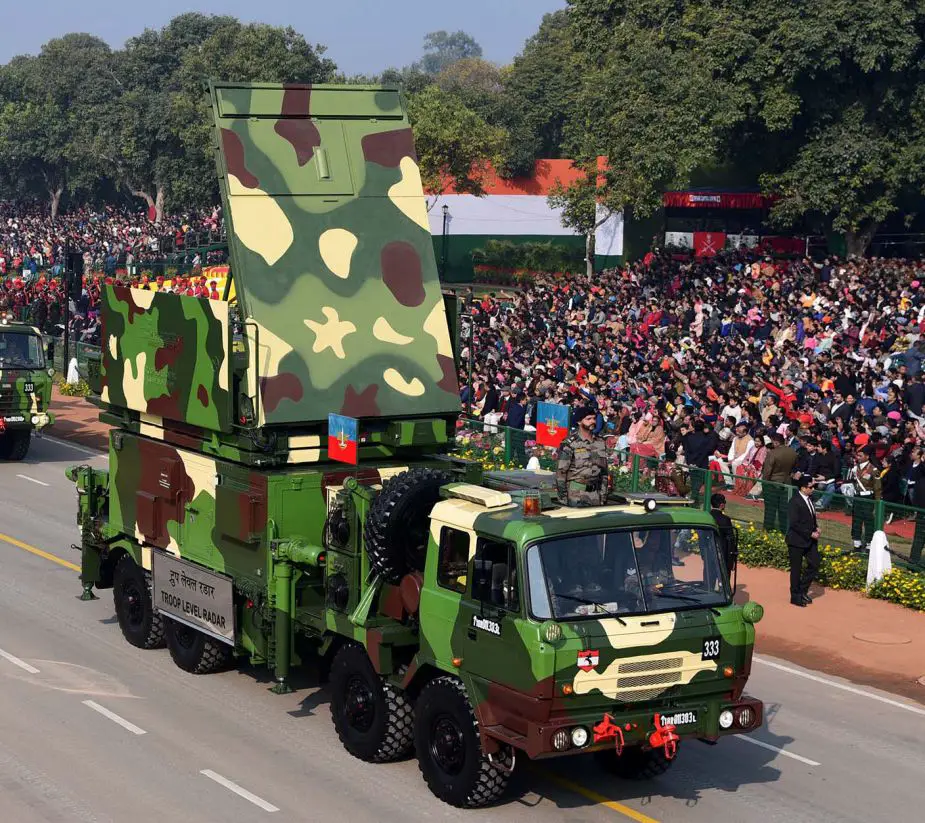
Troop Level Radar for Akask air defense missile system. (Picture source India Mod press service)
Troop Level Radar for Akash air defense missile system
The Troop Level Radar is part of Akash Indian-made surface-to-air defense missile system. Each Akash troop has four launch vehicles with three missiles each and are known as AAL, one Troop Level Radar (TLR) mounting the Rajendra with its Power Supply Vehicle (TPSV), one Radar Sensor Vehicle (RSV) which is equipped with the 3D-CAR radar along with its Data Center Vehicle (DCV) which houses the radar consoles, data processor unit and communication unit, the CPV and the 3D-CAR Power Supply Vehicle (CPSV).
The Troop Level Radar (TLR) vehicle is fitted with the 3D radar Rajendra designed to detect and track air targets up to a range of 150 km. The antenna is rotated mechanically in azimuth to provide 360° coverage. The radar can be operated at 15 RPM (Rounds Per Minute) and 7.5 RPM.
The TLR Rajendra radar makes use of a passive phased array to search a volume of space, distinguish between hostile and friendly targets, automatically track up to 64 targets and command one of several launchers to engage up to 4 targets simultaneously. Initially designed as a standalone system, Rajendra is now equipped with the ability to integrate with a network of sensors, including long and medium-range surveillance radars of foreign and domestic origin.
Rajendra's multi-element antenna arrangement folds flat when the vehicle is in motion. The Radar consists of a surveillance antenna array with 4000 phase control modules (PCM's) operating in the G/H-Band (4-8 GHz), an engagement antenna array with 1000 PCM's operating in the I/J-Band (8-20 GHz), a 16-element IFF array and steering units. A powerful high-end computer computes phases for all the elements of the array. Rajendra controls the beam positioning sequence through-beam requests for each track at adaptive data rates and performs multifunctional roles like search –confirm –track -interrogate targets, assign and lock-on launchers, and launch/acquire/ track/guide missiles. The RDP supplies track data to the remote group control center. Rajendra features a Dual channel radar receiver and a C band transmitter, although the complete transmitting and receiving features and bands are unknown.
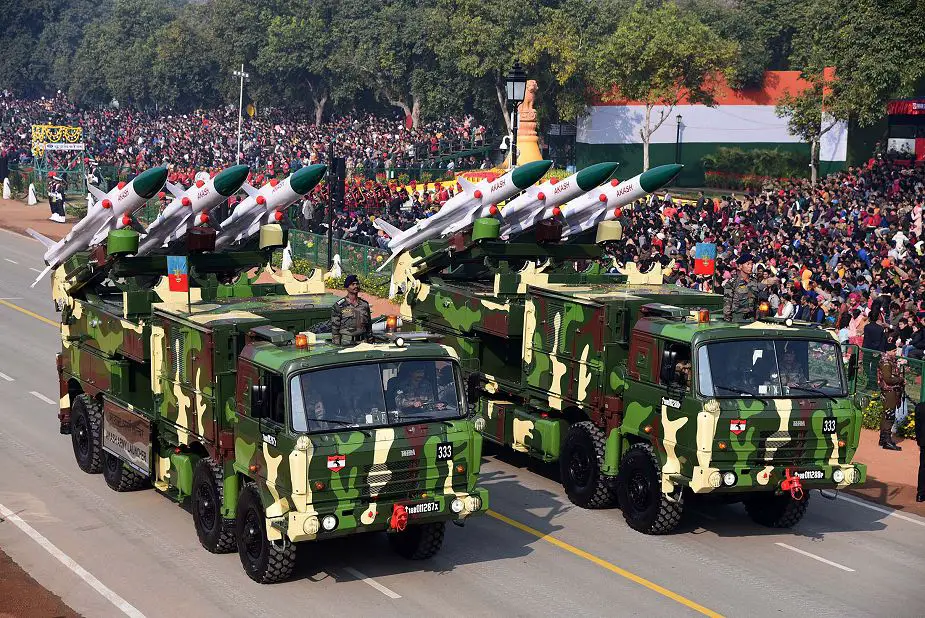
Akash Army launcher air defense missile system. (Picture source India Mod press service)
Akash Army launcher on 8x8 truck
The Akash army Launcher is a mobile air defense missile system mounted on BEML Tatra 8x8 truck chassis designed and manufactured by India's state-owned Defence Research and Development Organisation (DRDO). The development of the Akash missile system was started in 1983 with the first production in 2002. The first trial firings occurred in 1990 with the tenth stated test in September 1998.
The Akash missile has a launch weight of 720 kg and measures 5.8 m in length, 350 mm diameter and 1,10 5mm wingspan. The missile can fly at a speed of up to Mach 2.5 and has a height ceiling of 18 km. The 60 kg payload can use prefabricated tungsten alloy cubes warheads or a nuclear warhead. The Akash can intercept aerial targets from a range of 30 km and provide air defense missile coverage of 2,000 km².
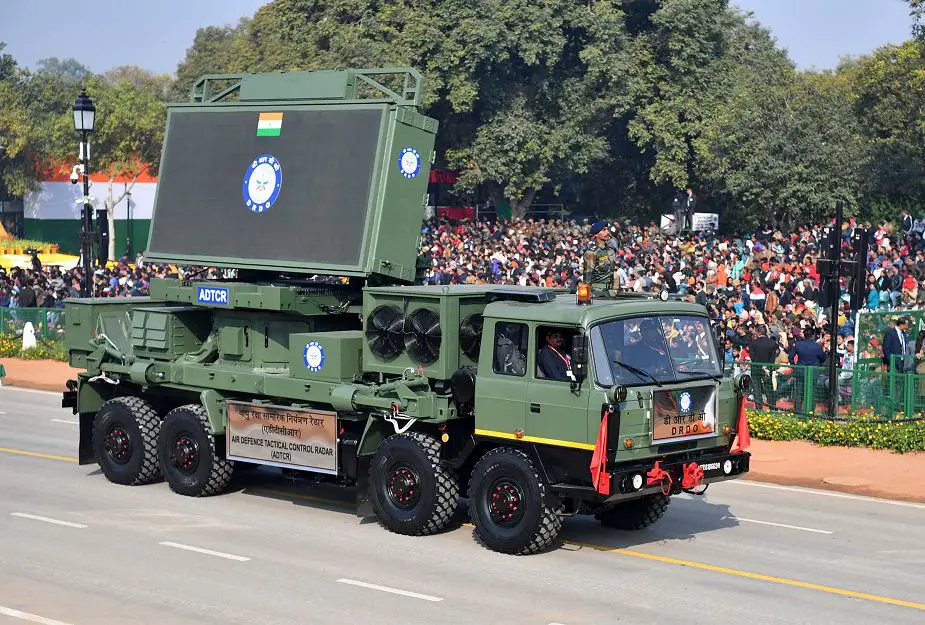
Air Defense Tactical Control Radar (ADTCR). (Picture source India MoD press service)
Air Defense Tactical Control Radar (ADTCR)
The Air Defence Tactical Control Radar (ADTCR) is used for volumetric surveillance, detection, tracking and friend/foe identification of aerial targets of different types, and transmission of prioritized target data to multiple command posts/ weapon systems. The radar is capable of detecting very small targets and low flying targets. The system employs Active Phased Array Technology with Digital Beam Forming, distributed Digital Receivers and IFF Mark XII.
The Radar System, power & cooling systems, operator shelter, communication equipment etc. is configured on two High Mobility Vehicles. The Radar can be deployed in plain lands, deserts and in the mountain regions for the purpose of tactical early warning for Ground-based Weapon Systems.
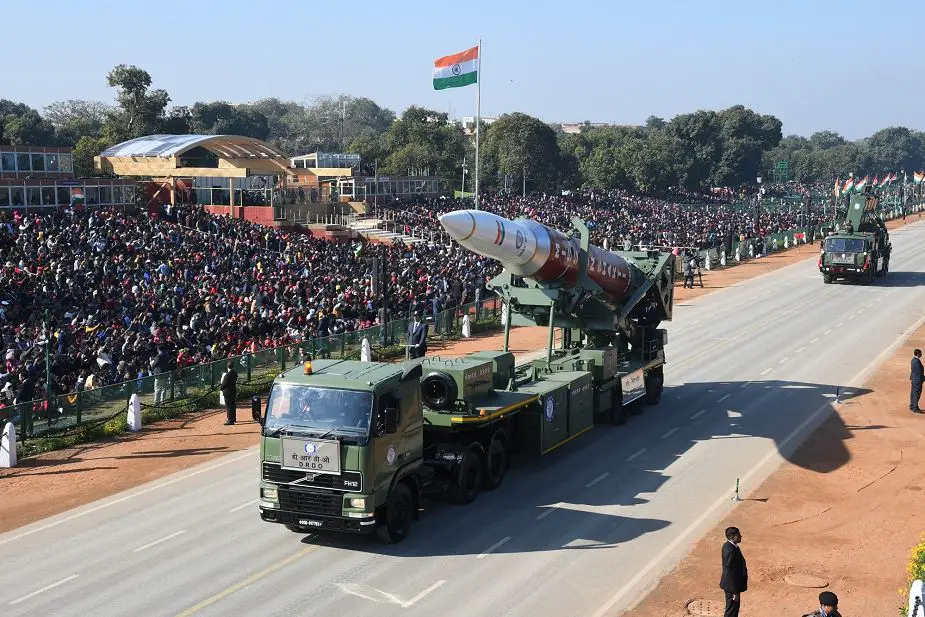
Anti-satellite missile system. (Picture source India MoD press service)
Anti-satellite missile system
With space becoming a vital dimension of any country's economic and military superiority, A-SAT (Anti-Satellite) weapons play a critical role in providing the necessary strategic deterrence.
In March 2019, the Defence Research Development Organisation (DRDO) launched 'Mission Shakti', India's first A-SAT mission and demonstrated its anti-satellite technology.
The Anti-satellite missile system is a missile mounted a trailer able to destroy a live orbiting satellite in the Low Earth Orbit (LEO) in a "Hit to Kill" mode. The covert technology of 'hit to kill', developed for the first time by India for such applications, enables it to destroy an enemy satellite by directly colliding with it with pin-point accuracy.
















